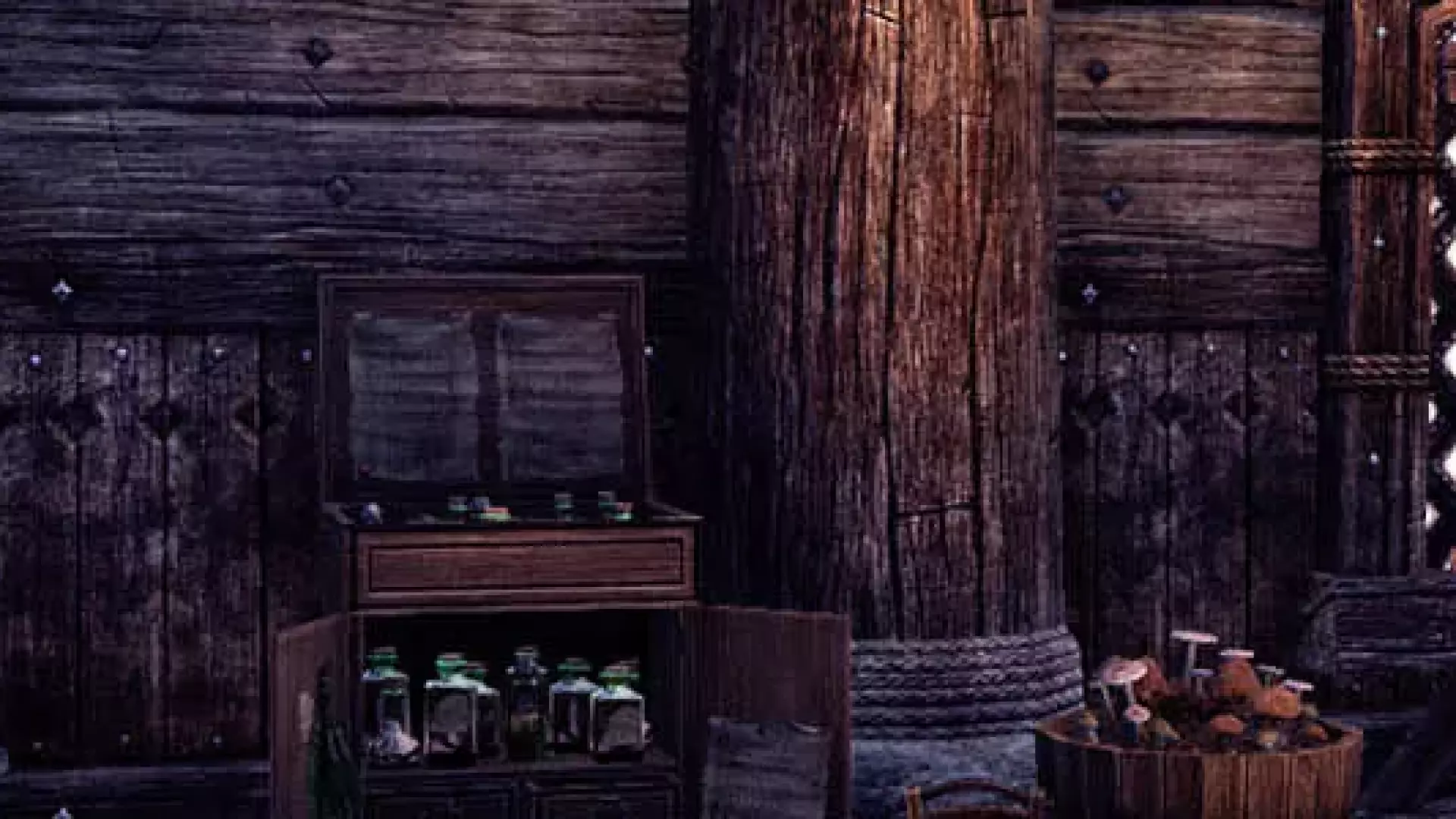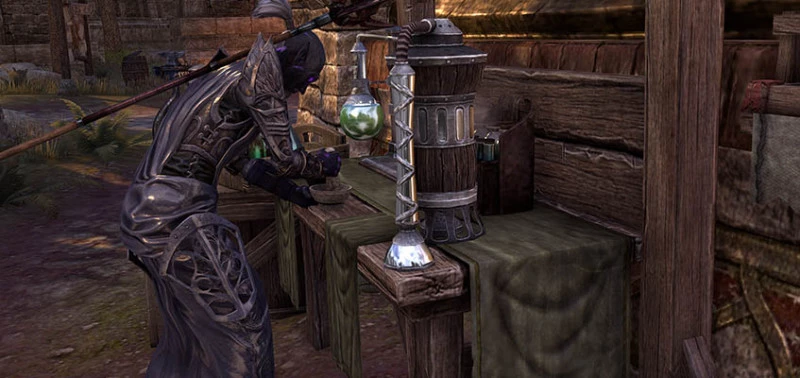Depending on the mixture, you can determine the use and the strength, meaning which level you can use it for and how powerful it will be. As an alchemist you gather these materials either by yourself, or by buying them from other players. Generally though you can find the ingredients anywhere, no matter what you do. Oftentimes you don't even need to search for them but will stumble upon them by walking through the world and interacting with things.
Because of the sheer amount of materials needed for ESO Alchemy, the Crafting bag that comes with ESO Plus is highly recommended. It's basically a bottomless and limitless bag, otherwise you will have to manage your inventory very strictly - which can work, but can be time-consuming.
Every reagent has several traits, which can only be analyzed and thus learned. You can analyze a reagent's trait by mixing it with other reagents and solvents. You can also look them up on this page, of course, but you still need to have them identified in the game.
In order to create a potion or a poison you need to add a solvent to a combination of reagents. This way you can add up to 3 buffs or debuffs. You can only do so though if you can add three reagents at once, which is something you need to level on your Alchemy skill line.
In Alchemy you can also create Formulae. These are recipes which you need in order to create anything related to Lighting.
Alchemy and Alchemists in ESO
Alchemy in ESO is the process of crafting a potion or a poison, and alchemists gather natural reagents found growing in the world of ESO, and mixes them with solvents at an Alchemy Table to create potions and poisons. Particularly pure water will produce a potion, while various viscous oils can be used to produce poisons. The grade of the solvent will determine the potency of the product. Poisons are at their strongest when concentrated - the more effects that are present on a poison, the less potent each individual effect will become.
All reagents have hidden traits which determine a product's effects. Similar traits from different reagents must be stacked to bring out their magical qualities. Each trait can be countered by another trait, and if the wrong reagents are mixed together they might cancel each other out. A skilled Alchemist experiments to find reagent combinations that offer the best results.
Poisons that are crafted with positive effects, such as Restore Health, will drain that effect from the target to enhance the poisoner.
ESO Alchemy: Discovering Traits
The method by which an alchemist learns the traits of various reagents is by tasting them. The key word here is "taste"—there is no need to consume more than a single portion of a reagent, even if you find it appealing. And, based on what the sensechal tells me about your visit to your father's wine cellar, you've already determined that common liquors do not possess alchemical traits, even if consumed in quantity.
Tasting a reagent will reveal that ingredient's most obvious alchemical trait—but most have secondary and tertiary magical properties as well. Combining reagents and observing the results will reveal these hidden traits, some of which can be quite astonishing. As you experiment, your skill at alchemy will increase, and it will become easier to recognize these traits and combine them effectively.
You will also begin to notice that certain classes of reagents feature common or even matching traits. For example, the traits of flowers tend to be beneficial, while those of fungus are often detrimental—as you discovered last Morndas when, trying to finish all your homework at the last minute, you consumed nine different kinds of fungus within a few minutes. The resulting projectile regurgitation was most impressive.
Alchemy For My Apprentice
My dear apprentice, you have destroyed far too many of myalchemicalstocks to go unpunished. My own master would never abide such abject incompetence! "Can't take instruction," she'd say. "Nose in a book," she'd say. Luckily for your prospects, it is far less costly to write this simple manual than replace yet another cask of rare solvent.If you lose this manual, as I know you will, don't despair. I have invested your annual stipend toward printing multiple copies of this book and distributing them far and wide. In time, every alchemy station inTamrielshall have one.
Step One: Acquire Solvents
You already know that every potion requires a solvent to serve as the potion's base. If you ever paid attention to my lessons, you'd know the best solvent is clean water from a natural source. The purity of the water determines the quality of the potion, so the best sources are natural springs.
I must once again emphasize the need for fresh sources of water. Remember that incident with the healing draught? You cannot simply dip a flask into a stagnant pond, an ocean cove, or downstream from a tannery. I suppose you could find bottles of clean water about town, but it is best to do the work yourself.
Incidentally, your "rain barrel solvent" will never work. You are to cease your experiments immediately.
Step Two: Acquire Reagents
Alchemy is a study of combinations. Where solvents are a potion's base, reagents are the active ingredients. Each reagent bears four unique traits. I'm disinclined to explain the principles of quadratic amalgamation to you—again—but do try to remember the basics: match like with like.
Henceforth, you are to find all reagents in the wilds—not in my laboratory! Remember to look for plants and mushrooms. Plants and mushrooms, only! Under no circumstances should you deviate from this. "Squirrel powder" was an abomination against the Eight.
Furthermore, I must remind you to thoroughly clean both mortar and pestle after their use.
Step Three: Craft Potions
Bring a solvent and two reagents to any alchemy station. Different reagents are required, a fact I must stress once again. Combining bugloss with bugloss gets you nothing but foul-tasting water.
When you have what you need, put them together and craft your potion. Reagents with positive trait combinations will produce helpful potions, while those with negative trait combinations can cause harm to whoever is foolish enough to imbibe them. If none of your reagents' traits match, you lose both solvent and reagents.
Experiment with different reagents to see what you can produce. I leave it to you to determine their traits, but will remind you that ingesting a reagent can teach you its most basic trait. Just one—don't gorge yourself!
While I recall of it, did you expect I wouldn't know you'd finished off the nirnroot? I could hear your teeth singing, and there's no way to hide a glowing chamber pot.
Advanced Alchemical Principles
Only when you master the basics of alchemy should you think to complicate the process. Through careful study you can learn to suppress negative traits when crafting potions, craft multiple potions from the simple set of reagents, or even combine additional reagents to produce more powerful potions!
But for now, "not poisoning yourself" is the goal I'd most like you to achieve.
 Deutsch
Deutsch
 Français
Français
 Русский
Русский
 Español
Español










































































































































































































































































































































































































